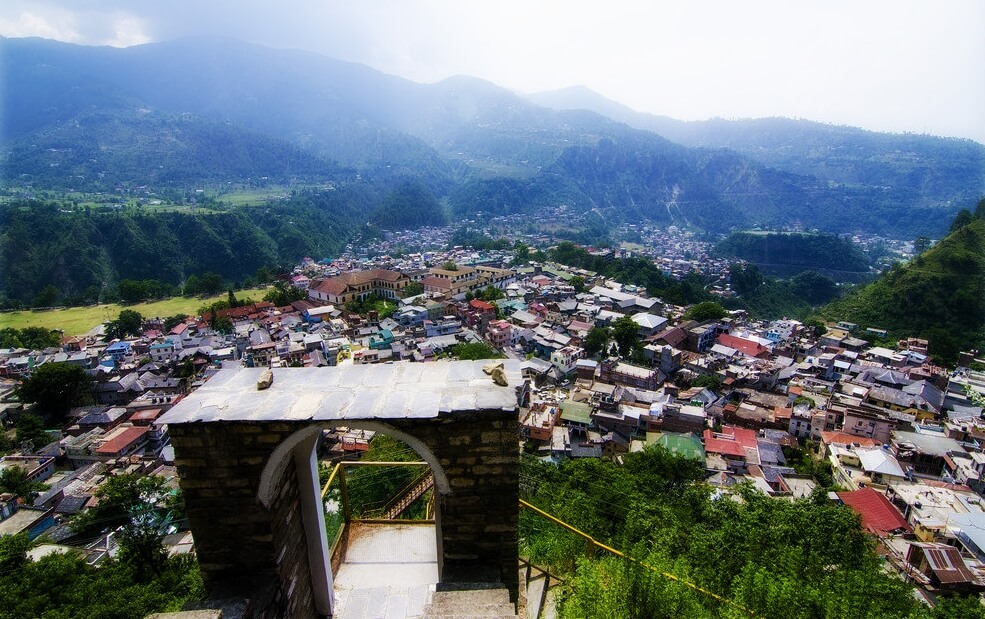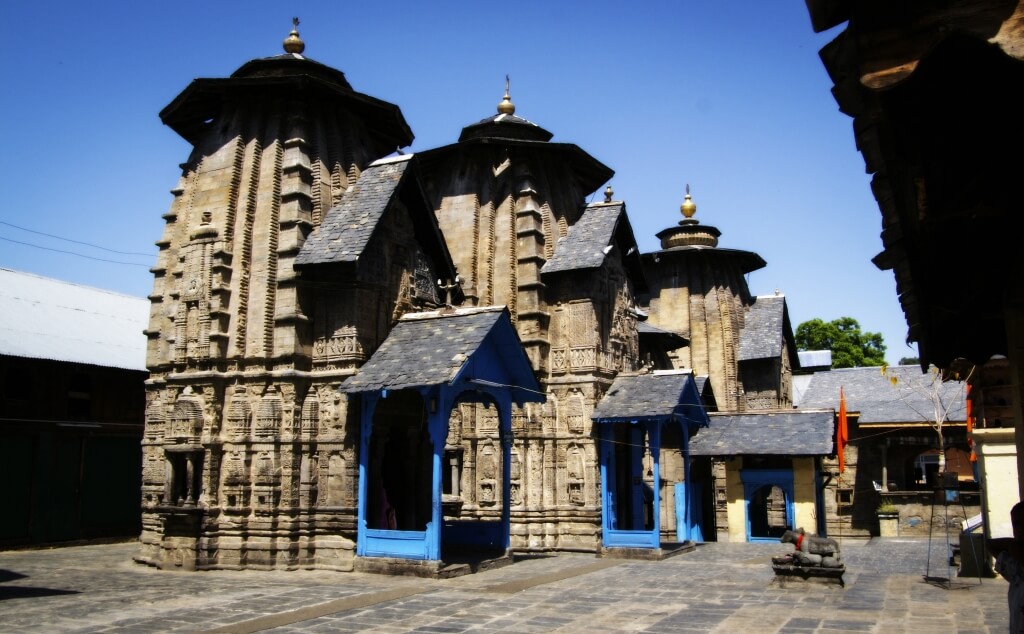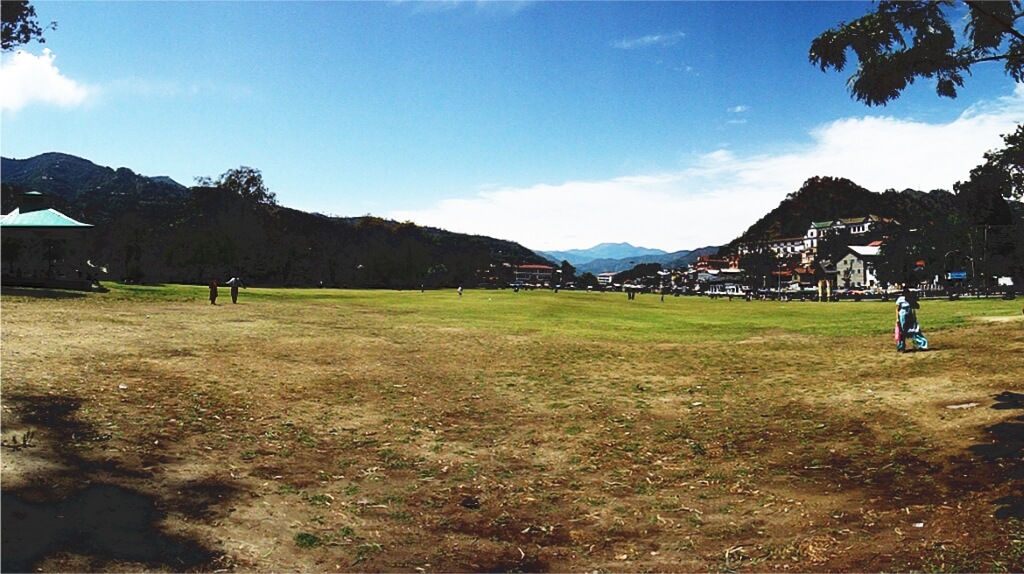Chamba, located in the mid of western Himalayan ranges is geographically a region where the density of trees like “Baan” and “Dyar” is high, and the beautiful sounds of birds chirping on them, and streams of rivers and fountains with grandeur spread their instinctive beauty in every direction. Chamba is located at 3200 feet above sea level. In its background there are the many mountain peaks of Dhauladhar and Pangidhar standing high immobile more than 20,000 feet. In addition to these unique features, this whole area is known for its historical and archaeological remains. One of the former princely state of Chamba Hill has a long history. In ancient times the capital of the principality was “Brahmapur” ie “Bharmour”. There is a saying that the 10th Century king ‘Sahil Verma‘ on the wish of his daughter “Champawati” inhabited a town here and named it “Champa” and had moved his capital here. Another lore is that this place was ever graced with “Chammpak forests“. There was the patron goddess called “Champa”. After a victory in battle, a king built a temple of “Champa Devi” and also inhabited the city. “Champa” later began to be called the Chamba.

Chamba town seen from Sui Mata Temple
City of Temples
The city is started with a small bus stand and a market. After some distance then starts the main part of town. There are many nice hotels there. There is a large field of grass appeared. This field is called “Chaugan”. You can see the entire Chamba city situated on the mountain. This place is used to be the the polo ground of the kings, today is a spacious garden and the fair ground. In front of it, there are government offices and hotels along with road. On the other hand, there is a road on which the cafeteria of Tourism Department “Raavi View” is situated. The in-depth view of the river “Raavi” flows is worth watching. Originating from “Bada Bhangal” the river “Raavi” also brings the water from its small sister rivers. The ancient Sanskrit name of the river Ravi is “Iraavati”.

Lakshmi Narayan Temple Chamba
Chamba is also known as the ‘Mandir Nagri’ (Town of Temples). There are many historic temples. Laxmi Narayan Temple is the most important of these. This is a group of six large and some small temples which is unique in both the religious and architecture approaches. Outside the entrance is the statue of Garuda on a high pillar made of metal. In the courtyard, there are three temples dedicated to Lord Vishnu and other three to Lord Shiva. The temple dedicated to Lakshmi Narayan, is the largest and oldest of these. Sri Radha Krishna Temple, Shri Chandragupta, Shri Gaurishankar, Shri Trimbakeshwar and Lakshmi Damodar temples around respectively. Shri Laxmi Narayan Mandir and Shri Chandragupta was built in the 10th century by Raja Sahil Varma. The temple, built in the remaining period of the later kings. These temples are built in the peak style architecture, top of it there is Kalash (vase), beneath it the ciborium is made of slate stones. In the corners of temple and back and forth there are gazebo built. Inside these beautiful sculptures are located. In Laxmi Narayan Temple, there is four faces and four armed anthropoid statue of god. It is built of the marble statue in the Kashmir style architecture. The archway remained behind Vishnu statue describes the Dashavatara. The statue is also called Vaykunth (empyrean). There is a Hanuman temple in the courtyard and some of Nandi Ganas shrines also there. These temples are in the care of the Department of Archaeology.

Akhand Chandi Palace
After the visit of temples we saw “Akhand Chandi”, the historic palace of the kings here. Mountain-style palace is not as magnificent as palaces of Rajasthan. The archaeological significance of the hill but it is an important architectural building. The museum contains many artifacts of the period. Rang Mahal is also a historic building. There is Himachal Handicraft and Handloom Corporation’s office in this building too.

Chamunda Devi Mata Temple Chamba
There is a Chamunda Devi temple on the top of a hill. There are around 400 stairs to reach the temple courtyard. Different from peak style architecture this temple is built on mountain style architecture. In typical mountain architecture, the roof of temple building is sloppy, so that the snow can not accumulate during snowfall. Most of the temples had a single roof. The use of wood in their construction was more. The walls of the sanctorum of the Chamunda temple made of wood and stone. There is beautiful statue of the goddess in the temple. There are other forms of goddess painted on the exterior walls. From the complex of goddess Chamunda which was the deity of Kings of Chamba you can see the panoramic view of the Ravi valley. Suhi Mata temple on another hill is about a kilometer away. The temple is a sorts of Queen Suhi’s monument. Some people say that in the 10th century, during the establishment of city, water stream reached there due to Queen Suhi sacrifice. A fair is held every year at the temple. On the occasion of the Suhi fair, the local girls use to sing in praise of Queen Suhi. These traditional songs are known as “Ghurei”. Other scenic temple in Chamba are Hari Rai temple, Brajeshwari Devi Temple, Champawati temple and Sheetla Mata Temple. People of Chamba who are associated with religious faiths, festivals and fairs in their lives have huge importance. On these occasions singing and dancing, colourful vestures and various cultural activities make the masses full of joy and harmony. Lohri and Baisakhi festivals are celebrated here with grandiosity .

View of the Chaugan Chamba
The Chamba’s Minjar Fair
When it comes to the culture of the people of Chamba, the name of “Minjar fair” is first appears on the tongue. The people of the Chamba district eagerly await the event. Singing soulful and melodious songs these folks come to fair by gathering in groups. This historical fair is connected to the agricultural and every year is celebrated during rainy season. When maize blossom with tassels, the farmers filled with glee. The same delight gave rise to the tradition of the Minjar fair. People wearing traditional costumes etc. are worshiped in temples. On this event, sweet and Minjar is sent to friends and relatives,. The procession of demi-gods and diety starts from the palace and ends at Chaugan. At that time, the view of crowd is worth watching at Chaugan. There are many cultural programs during the week long Minjar fair. On local instruments, Kunjdi, Malhar and other seasonal songs are sung and also the folk dance.
The Specific Style of Art
Chamba culture as well as the entire area is rich in terms of art. Kangra style Guler paintings are the typical art here. Fortresses and temples for centuries, continue the tradition of graffiti. Some ancient graffiti can still be seen here. In the case of metal sculpture the artisan had distinctive recognition . Began in the sixth century, the tradition is still alive. The Chamba slippers and Chamba handkerchiefs are counts in the souvenir. Due to the unique style of the two-sided embroidered Chamba handkerchiefs are famous throughout the country. This tradition thrived under the shelter of royal patronage has been adopted by today’s young women. By the beautiful combinations of silk threads mythological character, animals and landscapes are created on these handkerchiefs.
To understand the history of art and culture of Chamba we arrived at Bhuri Singh museum where the many evidences on the historical memories of Chamba are present. The collection of ancient inscriptions from Chamba and the surrounding areas, watering place fundamentals, sculptures, manuscripts are included. Kangra and Guler style miniature paintings of kings wear jewelery, pottery, weapons, coins and Chamba handkerchiefs, etc. Many things are placed here by bringing from the palaces. The museum’s current building, built in 1985, but was founded in 1908 by King Bhuri Singh. Tourists who visit the Chamba can also go to Sarol, Saluni and Bharmour. Bharmour is famous for its 84 temples of archaeological importance. Every year in August, people gathered here to the Manimahesh journey. Manimahesh is a beautiful lake located in the mountains. Grand fair is held every year.
The religious faith of the people and their humble attitude appealed to everyone. Himachal and Punjabi dialect mixed sweetness invites you to come back as tourists. Beauty and a unique mountain and folks had made a mark on our hearts. So it was obvious that we want to get lost in the beauty of the quiet time will prevail, we will come back again.



Comments